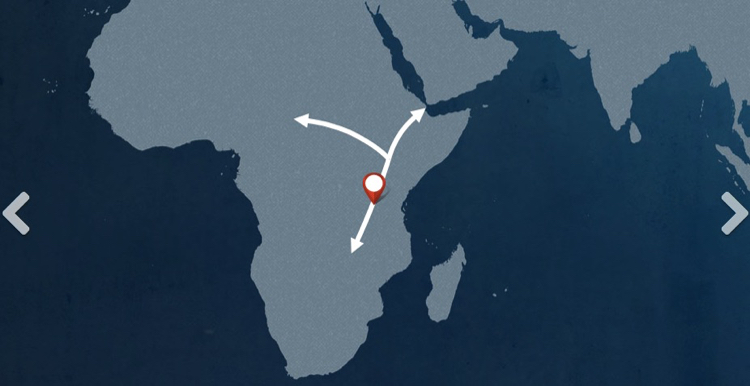
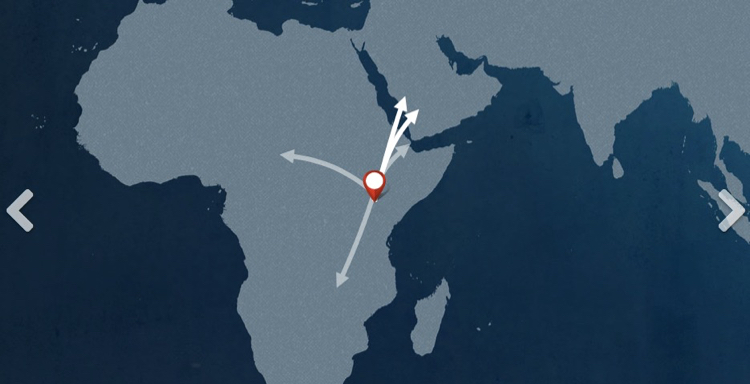
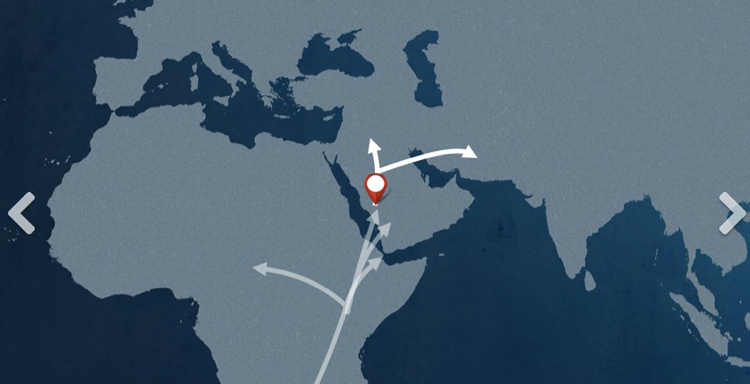
INTRODUCTION TO OUR STORY
Taken From DNA Testing by “The Genographic Project”
Results for Fuqua Paternal Line
DNA Donor: Mark Edward Fuqua
The 75,000 year Migration Path of the Fuqua Paternal Line
Our direct Fuqua paternal ancestor was born in the Rift Valley of eastern Africa about 75,000 years ago probably in modern day Kenya. The earliest known Fuqua was Jean Francois Fouquet, born in 1600 in Came, Bayonne, Pyrénées-Atlantiques, France.
The Journey
BRANCH: M42
AGE: ABOUT 75,000 YEARS AGO
LOCATION OF ORIGIN: AFRICA
The common direct paternal ancestor of all men alive today was born in Africa around 140,000 years ago. Dubbed “Y-chromosome Adam” by the popular press, he was neither the first human male nor the only man alive in his time. He was, though, the only male whose Y-chromosome lineage is still around today. All men, including your direct paternal ancestors, trace their ancestry to one of this man's descendants. The oldest Y-chromosome lineages in existence, belonging to the A branch of the tree, are found only in African populations.
Around 75,000 years ago, the BT branch of the Y-chromosome tree was born, defined by many genetic markers, including M42. The common ancestor of most men living today, some of this man's descendants would begin the journey out of Africa, to India and the Middle East. Small groups would eventually reach the Americas. Others would settle in Europe, and some from this line remained near their ancestral homeland in Africa.
Individuals from this line in Africa often practice cultural traditions that resemble those of their distant ancestors. For example, they often live in traditional hunter-gatherer societies. These include the Mbuti and Biaka Pygmies of central Africa, as well as Tanzania's Hadza.
As M42-bearing populations migrated around the globe, they picked up additional markers on their Y-chromosomes. Today, there are no known BT individuals without these additional markers.
POINT OF INTEREST
The M42 branch is shared by almost all men alive today, both in Africa and around the world.
BRANCH: M168
AGE: ABOUT 70,000 YEARS AGO
LOCATION OF ORIGIN: AFRICA/ASIA
As humans left Africa, they migrated across the globe in a web of paths that spread out like the branches of a tree, each limb of migration identifiable by a marker in our DNA. For male lineages, the M168 branch was one of the first to leave the African homeland.
Moving outward from Africa and along the coastline, members of this lineage were some of the earliest settlers in Asia, Southeast Asia, and Australia. Some from this line would even travel over the land bridge to reach the Americas.
The man who gave rise to the first genetic marker in your lineage probably lived in northeast Africa in the region of the Rift Valley, perhaps in present-day Ethiopia, Kenya, or Tanzania. Scientists put the most likely date for when he lived at around 70,000 years ago. His descendants became the only lineage to survive outside of Africa, making him the common ancestor of every non-African man living today.
But why would man have first ventured out of the familiar African hunting grounds and into unexplored lands? The first migrants likely ventured across the Bab-al Mandeb strait, a narrow body of water at the southern end of the Red Sea, crossing into the Arabian Peninsula soon after M168 originated—perhaps 65,000 years ago. These beachcombers would make their way rapidly to India and Southeast Asia, following the coastline in a gradual march eastward. By 50,000 years ago, they had reached Australia. These were the ancestors of today's Australian Aborigines.
It is also likely that a fluctuation in climate may have contributed to your ancestors' exodus out of Africa. The African ice age was characterized by drought rather than by cold. Around 50,000 years ago, though, the ice sheets of the northern hemisphere began to melt, introducing a short period of warmer temperatures and moister climate in Africa and the Middle East. Parts of the inhospitable Sahara briefly became habitable. As the drought-ridden desert changed to a savanna, the animals hunted by your ancestors expanded their range and began moving through the newly emerging green corridor of grasslands.
Your nomadic ancestors followed the good weather and the animals they hunted, although the exact route they followed remains to be determined. In addition to a favorable change in climate, around this same time there was a great leap forward in modern humans' intellectual capacity. Many scientists believe that the emergence of language gave us a huge advantage over other early human species. Improved tools and weapons, the ability to plan ahead and cooperate with one another, and an increased capacity to exploit resources in ways we hadn't been able to earlier, all allowed modern humans to rapidly migrate to new territories, exploit new resources, and replace other hominids such as the Neanderthals.
POINT OF INTEREST
This male branch is one of the first to leave the African homeland.
BRANCH: M89
AGE: AROUND 50,000 YEARS AGO
LOCATION OF ORIGIN: SOUTH ASIA OR WEST ASIA
The next male ancestor in your ancestral lineage is the man who gave rise to M89, a marker found in 90 to 95 percent of all non-Africans. This man was born around 50,000 years ago in northern Africa or the Middle East.
The first people to leave Africa likely followed a coastal route that eventually ended in Australia. Your ancestors followed the expanding grasslands and plentiful game to the Middle East and beyond, and were part of the second great wave of migration out of Africa.
Beginning about 40,000 years ago, the climate shifted once again and became colder and more arid. Drought hit Africa and the grasslands reverted to desert, and for the next 20,000 years, the Saharan Gateway was effectively closed. With the desert impassable, your ancestors had two options: remain in the Middle East, or move on. Retreat back to the home continent was not an option.
While many of the descendants of M89 remained in the Middle East, others continued to follow the great herds of wild game through what is now modern-day Iran to the vast steppes of Central Asia.
These semi-arid grass-covered plains formed an ancient “superhighway” stretching from eastern France to Korea. Your ancestors, having migrated north out of Africa into the Middle East, then traveled both east and west along this Central Asian superhighway. A smaller group continued moving north from the Middle East to Anatolia and the Balkans, trading familiar grasslands for forests and high country.
Today, geneticists have found the lineage in 1 to 2 percent of Pakistani and Indian populations. However, it is about 4 percent of some Austro-Asiatic-language-family-speaking groups in India. It is about 9 percent of some Dravidian-language-family-speaking groups in India, and it is 9 to 10 percent of male lineages in Sri Lanka. In Borneo, it is about 5 percent of the population. In Malaysia, it is about 6 percent of the population.
BRANCH: M304
AGE: 18,900 – 44,500 YEARS AGO
LOCATION OF ORIGIN: SOUTH ASIA OR WEST ASIA
Geneticists have found this branch and its descendant lineages in North Africa, where it is 69 percent of male lineages in Tunisia, about 30 percent of male lineages in Egypt, and about 27 percent of male lineages in Sudan. In South Asia, it is 29 percent of male lineages in Pakistan, around 14 percent of male lineages in India, and about 19 percent of male lineages in Sri Lanka.
In Europe, this lineage is most common in Italy (30 percent), Spain (20 percent), and Portugal (18 percent).
Today, descendants of this line appear in the highest frequencies in the Middle East, North Africa, and Ethiopia, and at a much lower frequency in Europe, where it is observed exclusively in the Mediterranean area. Approximately 20 percent of the males in southern Italy carry the marker, along with 10 percent of men in southern Spain.
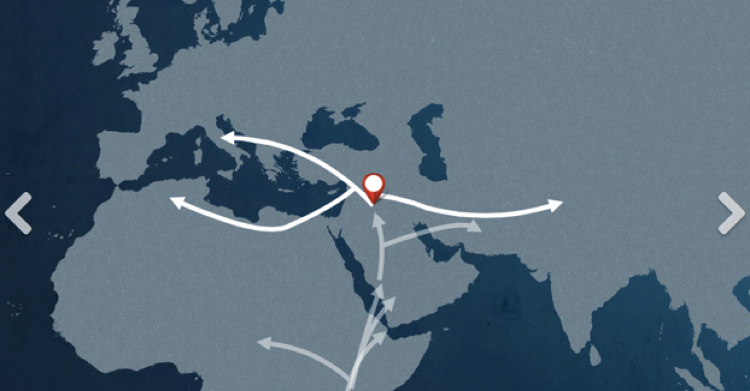
BRANCH: M172
AGE: 15,000 – 22,000 YEARS AGO
LOCATION OF ORIGIN: WEST ASIA
The earliest members of this lineage were nomadic hunter-gatherers who weathered the last glacial maximum in the comparatively mild climate of West Asia. As the Earth warmed, groups containing this lineage were positioned ideally for participation in the Neolithic Revolution in the Fertile Crescent of the Middle East. They thrived in the emerging agricultural societies and expanded into new lands, carrying farming technology with them.
This branch is a major lineage, and it has many descendants. Today, people from this lineage live as far east as China (1 to 2 percent) and as far west as Ireland (2 to 3 percent) and Spain (10 to 11 percent). Geneticists have found the highest frequencies in Bahrain and Iran, where it is over 33 percent of male lineages.
Today, descendants of this line appear in the highest frequencies in the Middle East, North Africa, and Ethiopia, and at a much lower frequency in Europe, where it is observed exclusively in the Mediterranean area. Approximately 20 percent of the males in southern Italy carry the marker, along with ten percent of men in southern Spain.
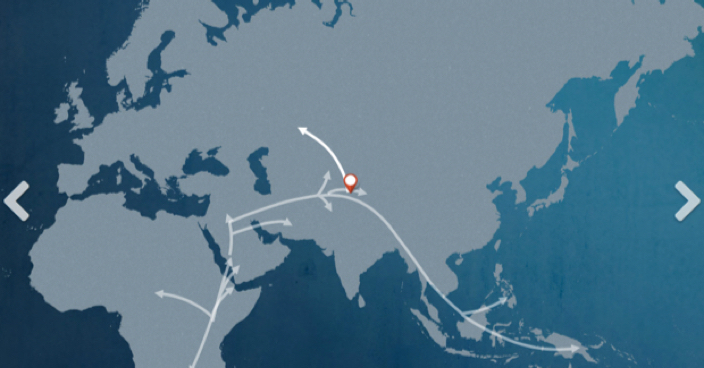
BRANCH: M221
AGE: 2,750 – 5,500 YEARS AGO
LOCATION OF ORIGIN: WEST ASIA
With the emergence of new metalworking technologies and Beaker culture, groups containing this lineage spread through migration along emerging Bronze Age trade routes.
Today, it is widely distributed in Europe, West Asia, and South Asia. It is about 3 percent of male lineages in Romania. In Greece, it is between 2 and 3 percent of the male population. It is about 2 percent of male lines in Croatia, 8 percent of male lines in Serbia, and 5 percent of male lines in Slovenia. In South Asia, it is about 5 percent of male lineages in Sri Lanka and between 2 and 3 percent of male lineages in India.

BRANCH: M241
AGE: BRONZE AGE
LOCATION OF ORIGIN: WEST ASIA
Groups containing this lineage moved from their homeland west into Anatolia and on to the Mediterranean region of Europe. Others from this paternal line traveled into South Asia.
Today, it is about 14 percent of Albanian male lineages. It is around 4 percent of the Greek male population. It is between 1 and 3 percent of Croatian male lineages. It is part of some Jewish Diaspora groups. It is about 5 percent of Slovenian male lineages. It is present at trace frequencies of less than 1 percent in Central and Western Europe. In South Asia, it is around 1 percent of the male population in India and 2 to 3 percent of the male population in Sri Lanka.
Note: This branch is not accompanied by a major movement on the map, and research on this branch is continuing.
HEATMAP FOR M241
This next step in your journey is a map showing the frequency of your haplogroup (or the closest haplogroup in your path that we have frequency information for) in indigenous populations from around the world, providing a more detailed look at where your more recent ancestors settled in their migratory journey. What do we mean by recent? It's difficult to say, as it could vary from a few hundred years ago to a few thousand years ago depending on how much scientists currently know about your particular haplogroup. As we test more individuals and receive more information worldwide, this information will grow and change.
The colors on the map represent the percentage frequency of your haplogroup in populations from different geographic regions—red indicates high concentrations, and light yellow and grey indicate low concentrations. The geographic region with the highest frequency isn’t necessarily the place where the haplogroup originated, although this is sometimes the case.
The map of M241 shows a wide distribution that has spread across southwestern Eurasia, the Arabian Peninsula, and North Africa. In Europe, there is a peak in the Greece and southern Italy.
Are you related to people in the areas highlighted on your map? Distantly, yes—we are all connected through our ancient ancestry.
In order for us to learn more ancestry information about where haplogroups settled in more recent times, please choose to contribute your results to science (check the checkbox during Login or from the Account Settings tab of your Profile), and fill out your ancestry information in the Profile section of the site. Also be sure to tell your own story in the Our Story section.
***************************************************************************************************************************************
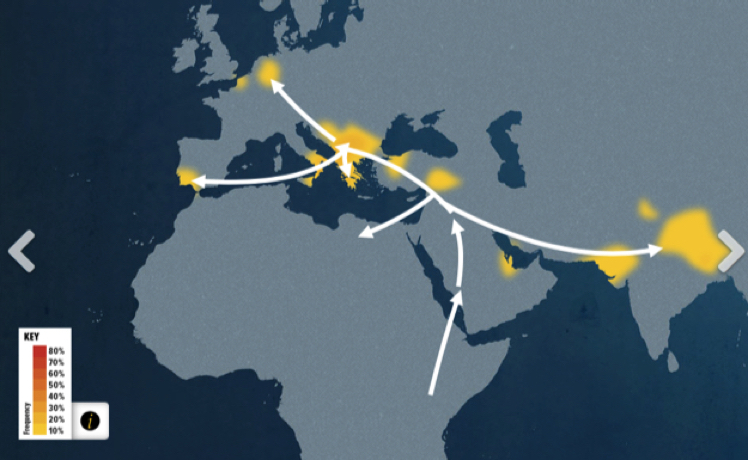
Taken From DNA Testing by “The Genographic Project”
Results for Maternal Line
DNA Donor: Victoria Lynn Fuqua Brashears
The 70,000 year Migration Path of the Victoria Lynn Fuqua Brashears Maternal Line
The Journey
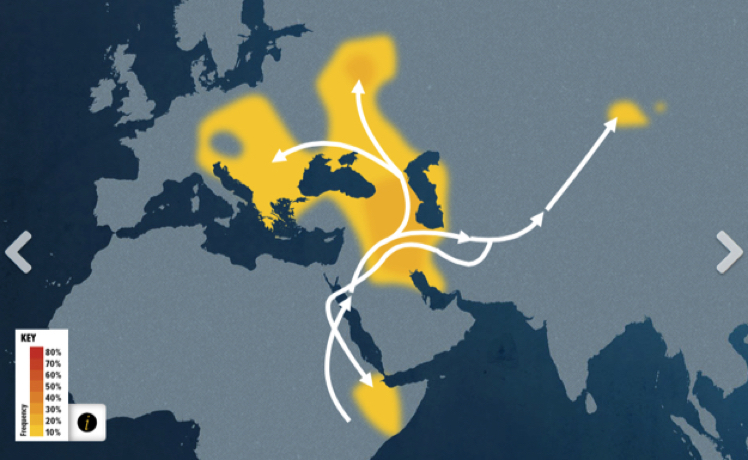
BRANCH: L3
AGE: 67,000 YEARS AGO
LOCATION OF ORIGIN: EAST AFRICA
This woman’s descendants would eventually account for both out-of-Africa maternal lineages, significant population migrations in Africa, and even take part in the Atlantic Slave Trade related dispersals from Africa.
The common direct maternal ancestor to all women alive today was born in East Africa around 180,000 years ago. Dubbed “Mitochondrial Eve” by the popular press, she represents the root of the human family tree. Eve gave rise to two descendant lineages known as L0 and L1’2’3’4’5’6, characterized by a different set of genetic mutations their members carry.
Current genetic data indicates that indigenous people belonging to these groups are found exclusively in Africa. This means that, because all humans have a common female ancestor, and because the genetic data shows that Africans are the oldest groups on the planet, we know our species originated there.
Eventually, L1’2’3’4’5’6 gave rise to L3 in East Africa. It is a similar story: an individual underwent a mutation to her mitochondrial DNA, which was passed onto her children. The children were successful, and their descendants ultimately broke away from L1’2’3’4’5’6, eventually separating into a new group called L3.
While L3 individuals are found all over Africa, L3 is important for its movements north. Your L3 ancestors were significant because they are the first modern humans to have left Africa, representing the deepest branches of the tree found outside of that continent.
From there, members of this group went in a few different directions. Many stayed on in Africa, dispersing to the west and south. Some L3 lineages are predominant in many Bantu-speaking groups who originated in west-central Africa, later dispersing throughout the continent and spreading this L3 lineage from Mali to South Africa. Today, L3 is also found in many African-Americans.
Other L3 individuals, your ancestors, kept moving northward, eventually leaving the African continent completely. These people gave rise to two important macro-haplogroups (M and N) that went on to populate the rest of the world.
Why would humans have first ventured out of the familiar African hunting grounds and into unexplored lands? It is likely that a fluctuation in climate may have provided the impetus for your ancestors’ exodus out of Africa.
The African Ice Age was characterized by drought rather than by cold. Around 50,000 years ago the ice sheets of northern Europe began to melt, introducing a period of warmer temperatures and moister climate in Africa. Parts of the inhospitable Sahara briefly became habitable. As the drought-ridden desert changed to savanna, the animals your ancestors hunted expanded their range and began moving through the newly emerging green corridor of grasslands. Your nomadic ancestors followed the good weather and plentiful game northward across this Saharan Gateway, although the exact route they followed remains to be determined.
POINT OF INTEREST
The L branch is shared by all women alive today, both in Africa and around the world. The L3 branch is the major maternal branch from which all mitochondrial DNA lineages outside of Africa arose.
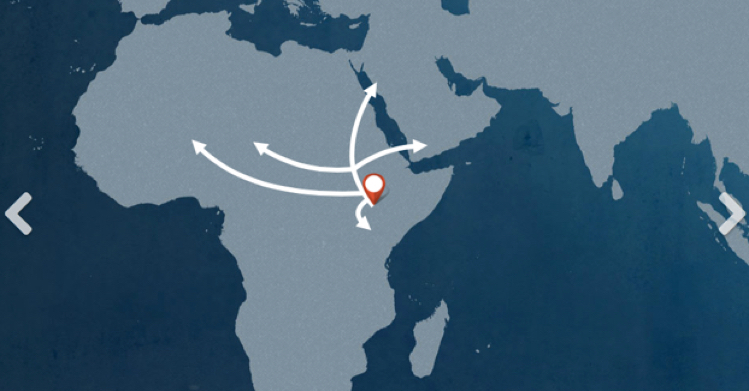
BRANCH: N
AGE: ABOUT 60,000 YEARS AGO
LOCATION OF ORIGIN: EAST AFRICA OR ASIA
Your next ancestor is the woman whose descendants formed haplogroup N. Haplogroup N comprises one of two groups that were created by the descendants of L3.
One of these two groups of individuals moved north rather than east and left the African continent across the Sinai Peninsula, in present-day Egypt. Also faced with the harsh desert conditions of the Sahara, these people likely followed the Nile basin, which would have proved a reliable water and food supply in spite of the surrounding desert and its frequent sandstorms.
Descendants of these migrants eventually formed haplogroup N. Early members of this group lived in the eastern Mediterranean region and western Asia, where they likely coexisted for a time with other hominids such as Neanderthals. Excavations in Israel’s Kebara Cave (Mount Carmel) have unearthed Neanderthal skeletons as recent as 60,000 years old, indicating that there was both geographic and temporal overlap of these two hominids. This likely accounts for the presence of Neanderthal DNA in people living outside of Africa.
Some members bearing mutations specific to haplogroup N formed many groups of their own which went on to populate much of the rest of the globe. These descendants are found throughout Asia, Europe, India, and the Americas. However, because almost all of the mitochondrial lineages found in the Near East and Europe descend from N, it is considered a western Eurasian haplogroup.
After several thousand years in the Near East, members of your group began moving into unexplored nearby territories, following large herds of migrating game across vast plains. These groups broke into several directions and made their way into territories surrounding the Near East.
Today, haplogroup N individuals who headed west are prevalent in Turkey and the eastern Mediterranean, they are found further east in parts of Central Asia and the Indus Valley of Pakistan and India. And members of your haplogroup who headed north out of the Levant across the Caucasus Mountains have remained in southeastern Europe and the Balkans. Importantly, descendants of these people eventually went on to populate the rest of Europe, and today comprise the most frequent mitochondrial lineages found there.
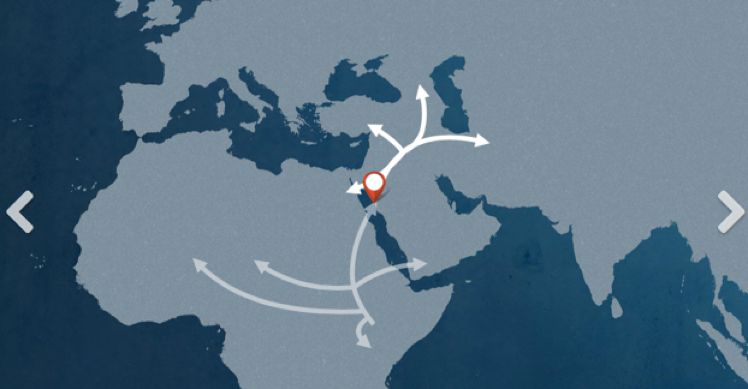
BRANCH: R
AGE: ABOUT 55,000 YEARS AGO
LOCATION OF ORIGIN: WEST ASIA
After several thousand years in the Near East, individuals belonging to a new group called haplogroup R began to move out and explore the surrounding areas. Some moved south, migrating back into northern Africa. Others went west across Anatolia (present-day Turkey) and north across the Caucasus Mountains of Georgia and southern Russia. Still others headed east into the Middle East, and on to Central Asia. All of these individuals had one thing in common: they shared a female ancestor from the N clan, a recent descendant of the migration out of Africa.
The story of haplogroup R is complicated, however, because these individuals can be found almost everywhere, and because their origin is quite ancient. In fact, the ancestor of haplogroup R lived relatively soon after humans moved out of Africa during the second wave, and her descendants undertook many of the same migrations as her own group, N.
Because the two groups lived side by side for thousands of years, it is likely that the migrations radiating out from the Near East comprised individuals from both of these groups. They simply moved together, bringing their N and R lineages to the same places around the same times. The tapestry of genetic lines became quickly entangled, and geneticists are currently working to unravel the different stories of haplogroups N and R, since they are found in many of the same far-reaching places.
POINT OF INTEREST
Descendants of this line dominate the European maternal landscape, making up 75 to 95 percent of the lineages there.
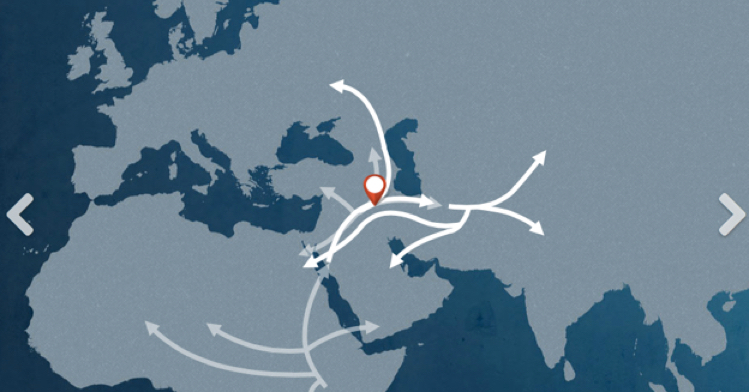
BRANCH: U
AGE: ABOUT 47,000 YEARS AGO
LOCATION OF ORIGIN: WEST ASIA
Descending from the R group, a woman gave rise to people who now constitute haplogroup U. Because of the great genetic diversity found in haplogroup U, it is likely that this woman lived around 47,000 years ago.
Her descendants gave rise to several different subgroups, some of which exhibit very specific geographic homelands. The very old age of these subgroups has led to a wide distribution; today they harbor specific European, northern African, and Indian components, and are found in Arabia, the northern Caucasus Mountains, and throughout the Near East.
One interesting subgroup is U6, which branched off from haplogroup R while still in the Middle East, moved southward, and today is found in parts of northern Africa. Today, U6 individuals are found in around ten percent of people living in North Africa.
Other members of the larger haplogroup U descend from a group that moved northward out of the Near East. These women crossed the rugged Caucasus Mountains in southern Russia, and moved on to the steppes of the Black Sea. These individuals represent movements from the Black Sea steppes west into regions that comprise the present-day Baltic States and western Eurasia. This grassland then served as the home base for subsequent movements north and west.
Today, this line is part of populations in Europe, West Asia (including Arabia), North Africa, India, and the North Caucasus Mountains. In Europe, this lineage averages 7 percent of the population. In Scandinavian countries (Norway, Sweden, the Netherlands, etc.) it is between 9 and 16 percent of the population. In England, it is about 12 percent of the population. Toward the Mediterranean, this line is between 10 and 12 percent of the population in Croatia and Greece.
POINT OF INTEREST
A subtype of this lineage links the Saami people in Scandinavia to Berber populations in North Africa.
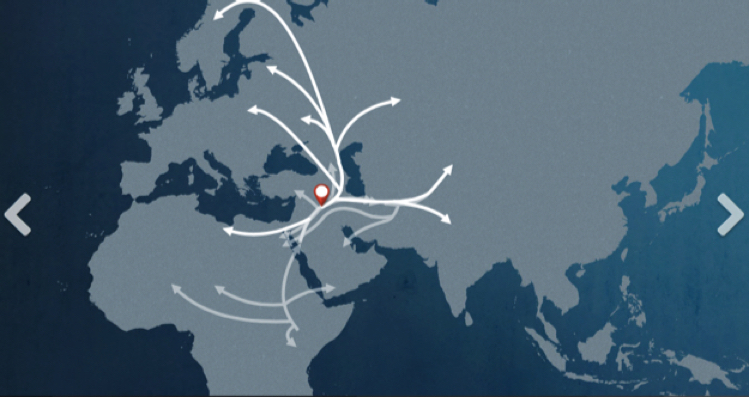
BRANCH: K
AGE: 27,000 YEARS AGO
LOCATION OF ORIGIN: WEST ASIA
Haplogroup K spawned from a group of individuals who descend from a woman in the U branch of the tree. Because of the great genetic diversity found in haplogroup K, it is likely that she lived around 27,000 years ago.
Her descendants gave rise to several different subgroups, some of which exhibit very specific geographic homelands. The very old age of these subgroups has led to a wide distribution; today they harbor specific European, northern African, and Indian components, and are found in Arabia, the northern Caucasus Mountains, and throughout the Near East.
While some members of your haplogroup headed north into Scandinavia, or south into North Africa, most members of your haplogroup K stem from a group of individuals who moved northward out of the Near East. These women crossed the rugged Caucasus Mountains in southern Russia, and moved on to the steppes of the Black Sea.
Around half of all Ashkenazi Jews trace their mitochondrial lineage back to one of four women, and your haplogroup K represents a lineage that gave rise to three of them. While this lineage is found at a smaller frequency in non-Ashkenazi Jews, the three K lineages that helped found the Ashkenazi population are seldom found in other populations. While virtually absent in Europeans, they appear at frequencies of three percent or higher in groups from the Levant, Arabia, and Egypt. This indicates a strong genetic role in the Ashkenazi founder event, which likely occurred in the Near East.
The term “Ashkenazi” refers to Jews of mainly central and eastern European ancestry. Most historical records indicate that the founding of Ashkenazi Jewry took place in the Rhine Basin where it subsequently underwent vast population expansions. In more recent times, the Ashkenazi population was estimated at approximately 25,000 individuals around 1300 A.D., whereas that number had increased to about 8,500,000 individuals by the turn of the twentieth century.
POINT OF INTEREST
Three of this line's descendant branches make up three of the four most common maternal lineages in Ashkenazi Jews.
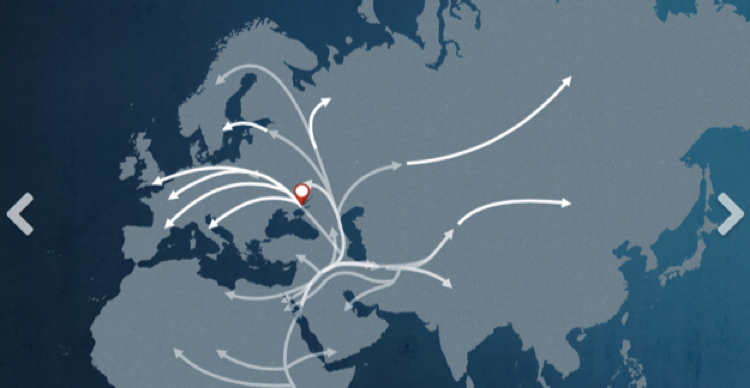
BRANCH: K1
AGE: ABOUT 22,000 YEARS AGO
LOCATION OF ORIGIN:
Note: This branch is not accompanied by a major movement on the map, and research on this branch is continuing.
BRANCH: K1C2
AGE: 3,800 YEARS AGO
LOCATION OF ORIGIN: EUROPE
Today, this lineage is present across all of Europe at low frequencies. Members are most common in northwestern Europe, where they are between 1 and 2 percent of maternal lineages in countries such as Scotland, Denmark, and Ireland.
Note: This branch is not accompanied by a major movement on the map, and research on this branch is continuing.
HEATMAP FOR K1C2
A heat map for your specific haplogroup is not yet available. We hope that as more people from around the world participate in the project we will be able to create a more specific map. We're showing you a heat map for an earlier branch in your path: K1.
This next step in your journey is a map showing the frequency of your haplogroup (or the closest haplogroup in your path that we have frequency information for) in indigenous populations from around the world, providing a more detailed look at where your more recent ancestors settled in their migratory journey. What do we mean by recent? It's difficult to say, as it could vary from a few hundred years ago to a few thousand years ago depending on how much scientists currently know about your particular haplogroup. As we test more individuals and receive more information worldwide, this information will grow and change.
The colors on the map represent the percentage frequency of your haplogroup in populations from different geographic regions—red indicates high concentrations, and light yellow and grey indicate low concentrations. The geographic region with the highest frequency isn’t necessarily the place where the haplogroup originated, although this is sometimes the case.
The map of K1 shows that it is primarily in the Middle East and Eastern Europe. K1 spread from its origin in the Fertile Crescent with the expansion of farming during the Neolithic Revolution.
Does this mean you’re related to people in the areas highlighted on your map? Distantly, yes! We are all connected through our ancient ancestry.
NEXT STEPS
Your results shown here are based upon the best information available today—but it is just the beginning. As we learn more, we may add new markers to your path, or modify your results to be more specific over time.
DNA markers require a long time to become informative. While mutations occur in every generation, it requires at least hundreds—normally thousands—of years for these markers to become windows back into the past, signposts on the human tree.
A fundamental goal of the Genographic Project is to extend these arrows further toward the present day. To do this, Genographic has brought together renowned scientists and their teams from all over the world to study questions vital to our understanding of human history. By working together with indigenous peoples around the globe, we are learning more about these ancient migrations.
WHO AM I?
We are all more than the sum of our parts, but the results below offer some of the most dramatic and fascinating information in your Geno 2.0 test. In this section, we display your affiliations with a set of nine world regions. This information is determined from your entire genome so we’re able to see both parents’ information, going back six generations. Your percentages reflect both recent influences and ancient genetic patterns in your DNA due to migrations as groups from different regions mixed over thousands of years. Your ancestors also mixed with ancient, now extinct hominid cousins like Neanderthals in Europe and the Middle East or the Denisovans in Asia. If you have a very mixed background, the pattern can get complicated quickly! Use the reference population matches below to help understand your particular result.
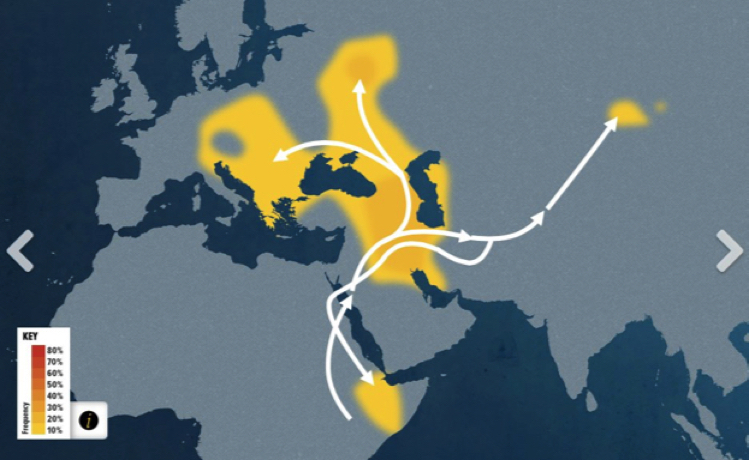
Enter Text
The DNA results for Victoria Lynn Fuqua Brashears below reveal the location of her most recent ancestors over the last 1,000 years or so. This testing was done through Ancestry.com.
Unlike the Y-chromosome or mitochondrial DNA test, AncestryDNA uses an autosomal DNA test that surveys a person’s entire genome at over 700,000 locations. It covers both the maternal and paternal sides of the family tree, so it covers all lineages. The Y-DNA test only reflects the direct father-to-son path in your family tree, and the mtDNA test only reflects the direct mother-to-child path in your family tree. Learn more about the differences between the DNA tests here.
The test is gender neutral. Both men and women can take the AncestryDNA test and are tested in the same way for the same number of markers providing the same level of detail in the results.
It predicts your recent genetic ethnicity. Thanks to advances in DNA technology we’re able to compare your DNA to samples from around the world, to find out more about your family’s background and ethnic history—not ancient history, but the people and places that matter to you.
Enhanced DNA matching. Unlike the Y-chromosome or mitochondrial DNA tests, the new AncestryDNA autosomal test looks at a much broader range of your DNA, which helps identify matches throughout your entire family tree—along both your paternal and maternal sides.
The information is more relevant and recent—targeting your family history a few hundred or even a thousand years ago, as compared to the Y and mtDNA tests, which have a 10,000 to 50,000 year time focus.
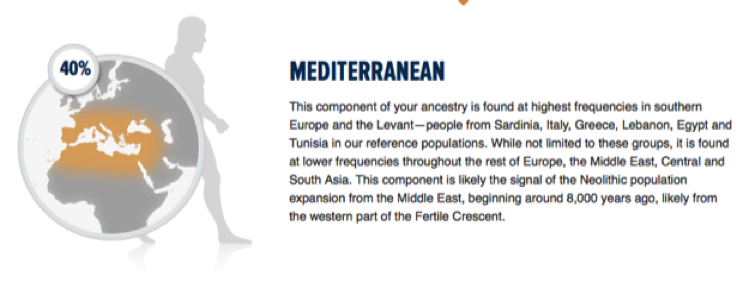
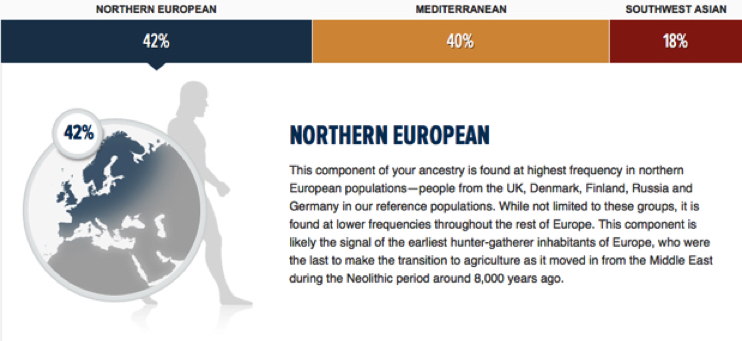
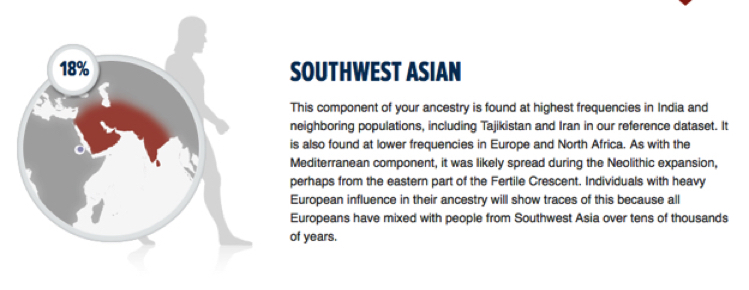
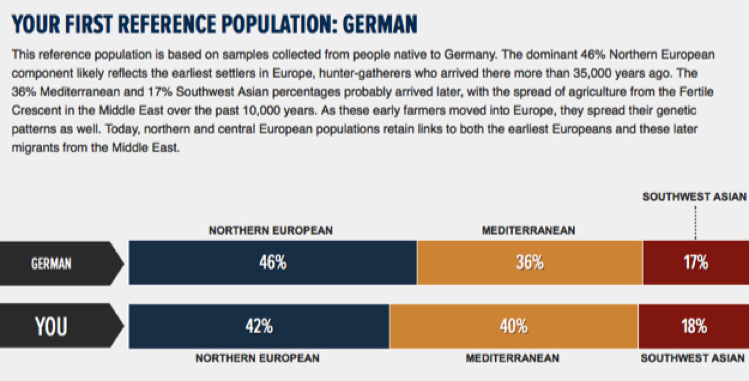
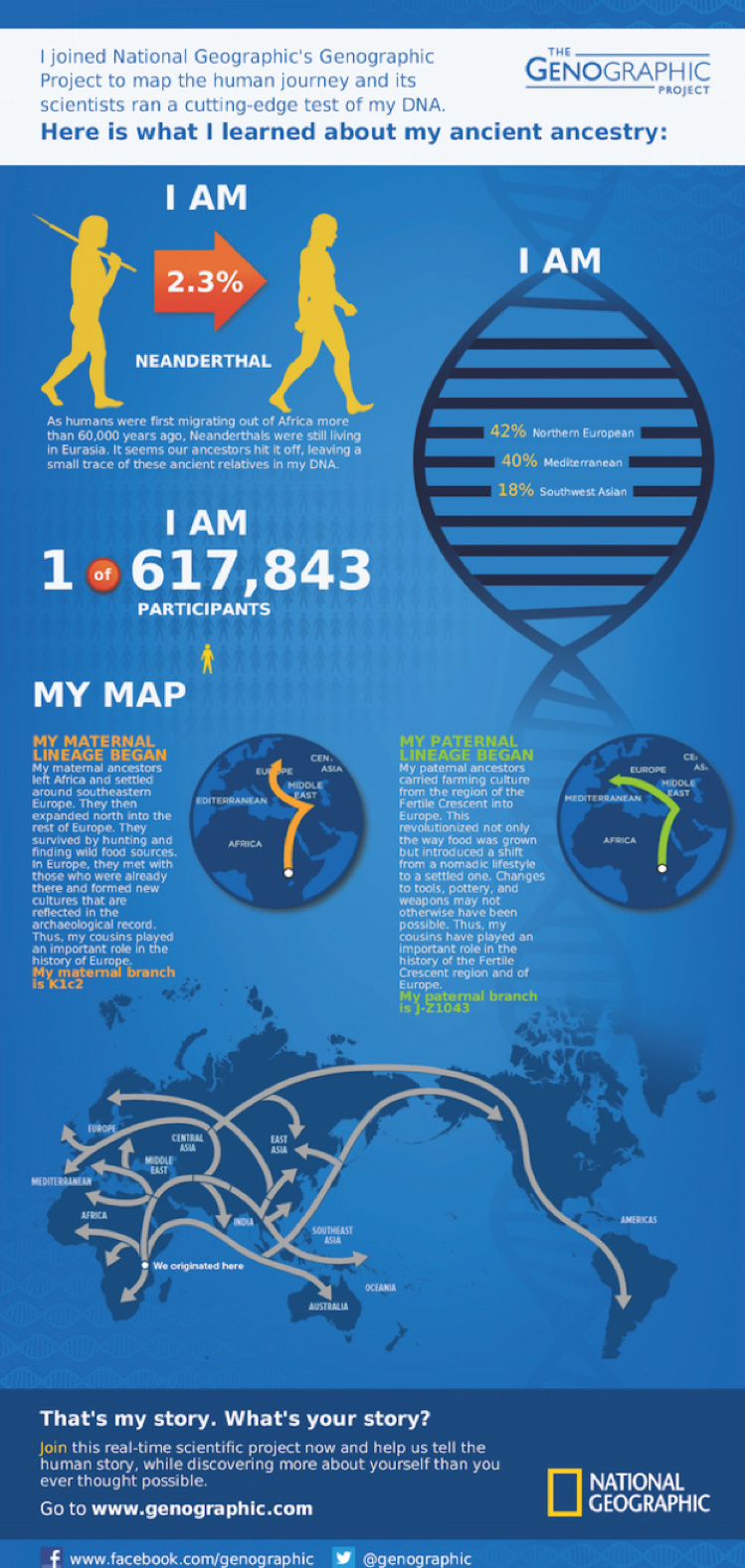
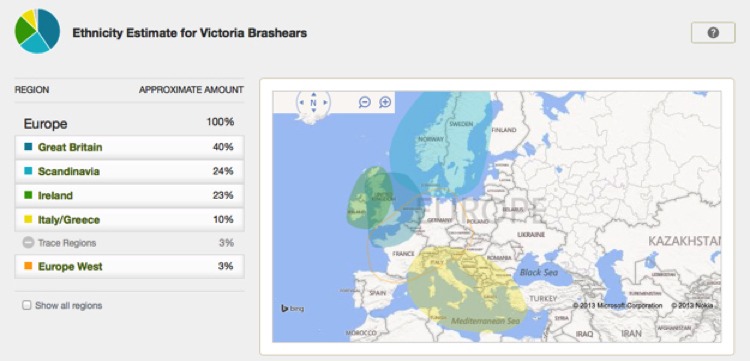
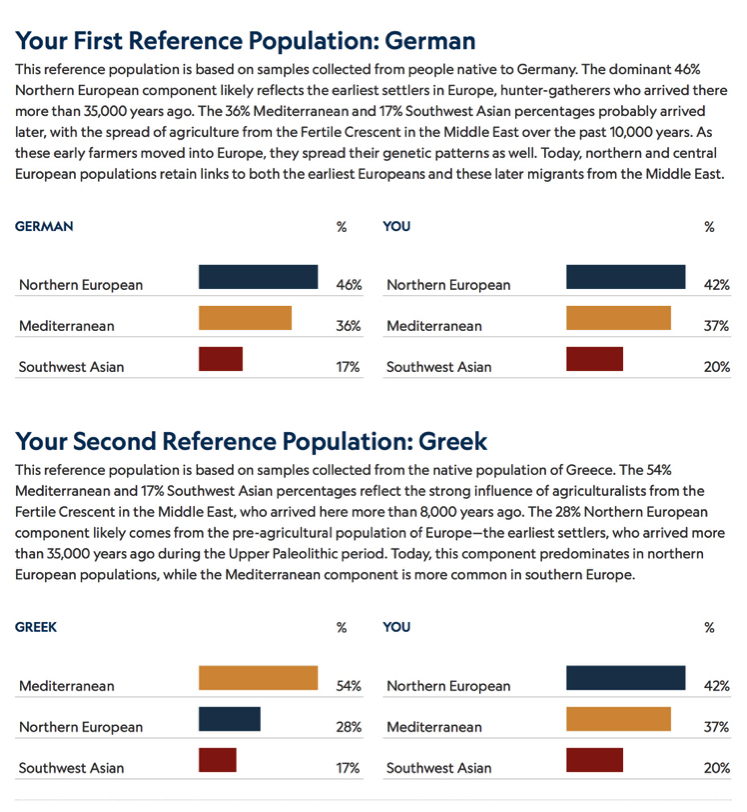
Update Reference Populations in 2018
Mark Edward Fuqua
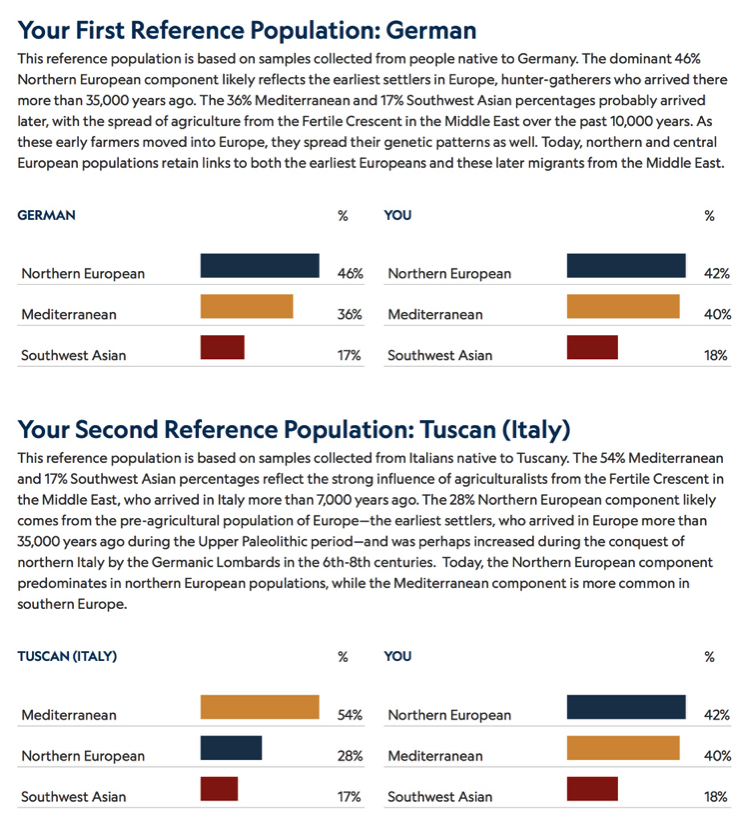
Update Reference Populations in 2018
Victoria Lynn Fuqua Brashears
